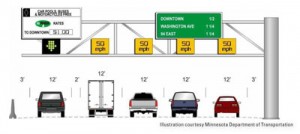What impacts do tolling, transit, technology and telecommuting/travel demand management have on reducing traffic congestion in major travel corridors? Researchers at the Texas Transportation Institute (TTI) are part of a team helping the U.S. Department of Transportation (U.S. DOT) answer that question.
The U.S. DOT is funding congestion reduction strategies at multiple sites throughout the country through the competitive Urban Partnership Agreement (UPA) and the Congestion Reduction Demonstration (CRD). Both programs are part of the U.S. DOT’s Congestion Initiative.
The selected sites—which include the metropolitan areas of Miami, Minneapolis-St. Paul, San Francisco, Los Angeles, Seattle and Atlanta—are implementing a wide range of innovative strategies. Examples of projects include high-occupancy toll (HOT) lanes, a priced dynamic shoulder lane, new and expanded park-and-ride facilities, dual downtown bus lanes, real-time transit information and lane guidance for shoulder running buses. Other strategies include variable pricing on existing freeways, active traffic management systems, variable priced on-street and off-street parking, improved regional 511 traveler information systems and telecommuting and flexible work arrangements.
The U.S. DOT also selected a national evaluation contractor through a competitive procurement process to assess the effectiveness of the various UPA/CRD strategies. The Battelle Memorial Institute team, which includes TTI, was selected to conduct the national evaluation.
“The national evaluation is assessing the impacts of the UPA/CRD projects in a comprehensive and systematic manner, as well as the specific impacts of technology, tolling and transit elements,” notes Shelley Row, director of the U.S. DOT’s Research and Innovative Technology Administration (RITA), ITS Joint Programs Office. “The evaluation results will benefit other metropolitan areas interested in deploying similar strategies and will support future federal policy and program development related to mobility and congestion and the role of pricing, transit and intelligent transportation systems.”
“We are working with representatives from the local agencies and the U.S. DOT in developing and conducting the evaluation,” notes Katie Turnbull, TTI executive associate director and lead on the Minnesota UPA site evaluation. “The team approach is critical to successfully evaluating the influence of these innovative programs.”
Other TTI researchers are serving as technical experts, providing assistance across all sites. Kevin Balke, research engineer, is the technology expert and David Ungemah, associate research scientist, is the tolling expert.
“Some projects, such as the HOT lanes in Miami and the Transit Advantage bus bypass lane in Minnesota, are in operation,” states Row. “Most of the projects will be implemented in late 2009, 2010 and early 2011. The national evaluation will provide preliminary results after the projects come online, as well as a comprehensive final assessment.”

